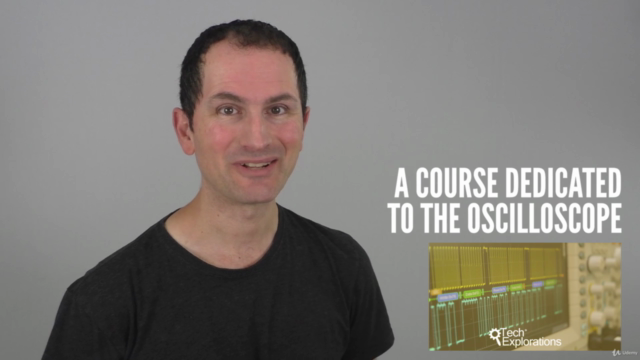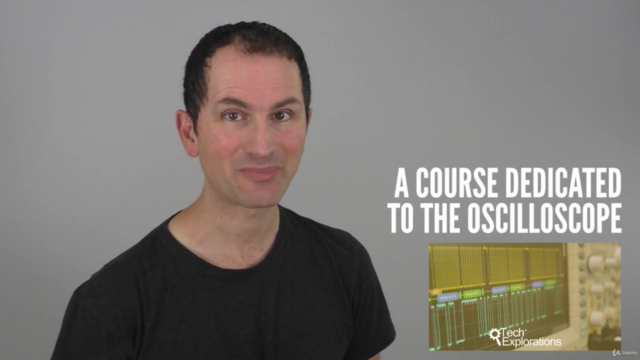Oscilloscopes for beginners

Why take this course?
🔬 Course Title: Oscilloscopes for Beginners
🚀 Course Headline: With this course, you will learn how to use the oscilloscope through a series of experiments!
About the Instructor: Dr. Peter Dalmaris is an Electrical Engineer with a passion for electronics education and innovation. His practical approach and hands-on experiments make complex subjects easy to understand.
Course Description: UPDATED January 20, 2020, with a new section and experiment
Oscilloscopes are incredible tools that can capture, display, and analyze an electrical input signal. They are powerful instruments capable of automatically producing a myriad of measurements like period, rise time, width, duty cycle, max and min voltages, and even decode communications protocols such as RS232, I2C, and more.
Are you working with electronics and interested in using an oscilloscope to gain a deeper understanding of what is happening inside your circuits as they operate? Perhaps you already own an oscilloscope but are overwhelmed by its features and functions? Or maybe you're considering purchasing one but unsure if it's the right choice or what features to look for?
This course is tailored for those exact scenarios. It will help you master the use of the oscilloscope you currently possess, or guide you in making an informed decision if you're planning to buy one.
Why You Should Take This Course:
-
Understanding Electronics Deeper: Beyond the multimeter, the oscilloscope is an essential tool for makers and electronics enthusiasts. It offers a two-dimensional view of how signals change over time.
-
Accessible Technology: With the cost of oscilloscopes plummeting, these devices are now within reach for students and hobbyists, offering professional-level capabilities on a budget.
-
Bridging the Gap: This course bridges the gap between basic electronics knowledge and practical oscilloscope usage. It assumes you have a grasp of concepts like Volt (V), Hertz (Hz), and duty cycle, as well as some familiarity with Arduino and ESP32 technologies.
What You'll Learn:
- Oscilloscope Features and Functions: Understanding the most critical features and how to operate them.
- Setting Up Your Oscilloscope: Calibrating your instrument for accurate measurements and ready use.
- Hands-On Learning: Engaging with experiments that will solidify your understanding of oscilloscopes through practical application. These experiments are designed to help you learn new workflows and operations, ensuring you can apply these skills in real-world scenarios.
Course Structure:
- An introduction to the world of oscilloscopes and their features.
- A step-by-step guide on setting up and calibrating your device.
- A series of experiments that will help you understand the practical application of an oscilloscope in various scenarios.
Enrol Now and Gain a Deeper Insight into Electronics with Oscilloscopes!
For a sneak peek into what this course entails, feel free to check out the free lectures, which will give you a better understanding of the objectives and structure of the full program.
Don't miss out on this opportunity to enhance your electronics skills with the powerful tool that is the oscilloscope. Enrol today and take the first step towards becoming an oscilloscope pro! 📡🔬🚀
Course Gallery




Loading charts...
Comidoc Review
Our Verdict
Oscilloscopes for Beginners" is a solid foundational course designed specifically for beginners who want to understand and practically use an oscilloscope. While the demonstrations can be repetitive at times and model-specific features might cause minor confusion, its hands-on experiments, safety guidelines, and comprehensive triggering coverage contribute to an overall rewarding experience. Minor improvements in real-life troubleshooting examples and a more detailed approach on various oscilloscope functionalities would enhance the course content further.
What We Liked
- Comprehensive course specifically tailored for beginners, allowing them to grasp the fundamentals of oscilloscopes.
- Hands-on experiments with wiring diagrams provide a practical learning experience.
- Covers essential safety aspects and confidence building for newcomers in electronics.
- Detailed explanation of complex triggering, useful for both digital and analog circuits.
- Instructor has excellent teaching skills and explains concepts clearly.
Potential Drawbacks
- Repetitiveness in demonstrations can lead to a loss of interest.
- Limited scope model-specific features may cause confusion with different models.
- Lack of real-world troubleshooting scenarios for practical experience.
- Insufficient in-depth information about each oscilloscope function.
- Safety rules and precautions could be expanded, specifically mentioning equipment safety.